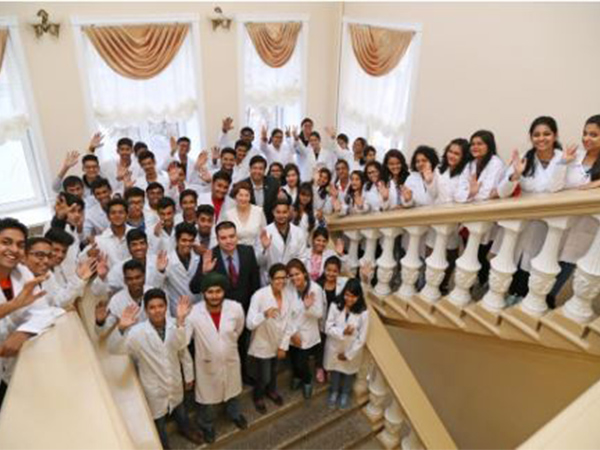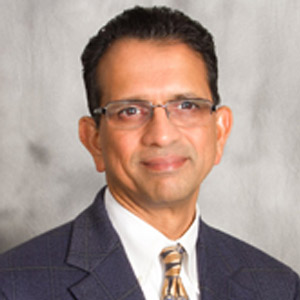Incorporating principles of diversity, inclusiveness, and expansion by adding new medical schools every year with specialized areas of Medicine, India’s model of medical education has now come to be a model for the rest of the world to emulate.
According to Dr. Lokesh Edara, who has been leading the efforts for AAPI’s Global Medical Education Initiatives and currently serving as the Chair of Board of Trustees of The American Association of Physicians of Indian Origin (AAPI), ever since gaining Independence from the colonial British rule, India has expanded its medical education program with 19 medical schools to now having 706 medical colleges in 77 years.

Under the leadership of Prime Minister Narendra Modi, India has taken medical education to newer heights. India created in a span of nine years, 317 new medical schools. Dr. Edara says, in 2014, there were 387 medical colleges having a total of 51,348 MBBs seats in the country. In 2023, the number of medical schools has expanded to 706 colleges with a total of 108,898 medical seats across the nation.
When it comes to the prestigious All India Institute of Medical Sciences (AIIMS), India had seven AIIMS in 2014. Today, the number of AIIMS has increased to 22. “The Indian model of AIIMS funded by the federal government should be a model to the rest of the world,” Dr. Edara said.
Another area, where the Indian model is significant for the rest of the world to emulate is its inclusiveness and encouraging of minority communities in the nation. India is the only country that has its constitution facilitating the establishment of minority institutions. India is home to the people of several minority religions, resulting in 2 medical schools for the Sikhs, 2 Christian medical schools, 2 Jain medical institutes, one Buddhist medical school and as many as 26 Muslim institutions, in addition to 6 Linguistic minority medical colleges.
Indian laws also provide reservation to students from minority and backward communities, with more than 50% of medical schools’ seats reserved for admission. “This is one of the best examples of diversity and inclusiveness in education in the world,” Dr. Edara said.
The presence of growing number of specialty education in Medicine, catering to the diverse, rural, urban and complex needs of the patients in each medical school is where India again leads the world. The MCI/NMC in India has mandated that there be departments catering to the specialty areas, catering to the special needs of each patient.
AAPI has been spearheading medical education advocacy programs for India, Dr. Edara pointed out. “The uniqueness of medical education in India is that Indian medical colleges have been mandated and they have as many as 23 specialized departments of medicine. NMC, NBEMS are also models in India for the rest of world for generating specialties of physicians.

Advancing medical education from High School onwards, many states in India have mandatory anatomy, physiology and biochemistry deportments, making them as essential subjects for students admitted from 12th Grade onwards. And for para medical departments, there are similar programs along with medicine, surgery, OBGYN and pediatrics.
Today, India boasts of more medical graduates with specialties in comparison with the rest of the world due to the establishment of clinically mandatory departments in medical colleges. For instance, in ophthalmology, India has 1927 seats vs the United States having 509 seats, which is 374% higher than that of the US. In the field of MS ENT/Otolaryngology, India has 1417 seats, while the US has 373 seats, an increase of 380% in India.
Seats for Orthopedics in India is 2847, while the US has 899 seats, with 222% greater number of seats in India. In Anesthesiology, India has 429 colleges with 4687 seats, while the US has 1746 seats, which is 268% more seats in India. There are as many as 2544 seats in India vs US having 1274 seats for post graduate studies in Hematology, which is 266% higher in India than USA.
With 1408 seats in India as against 528 seats in the US for Radio Diagnosis, which is 200% higher in India than in the US. Radiation Therapy/Oncology seats are 239% higher in India than the US with 457 seats in India vs 191 admissions in the US. There are as many as 1360 Psychiatry seats in India to the 2164 seats in the United States annually. In the field of Pulmonary/TB & Respiratory, the US has 1172 seats while India has 1045 MD seats today.
India is planning to create one Post Graduate seat to each MBBS graduate passing out from medical schools. AAPI has been advocating for post graduate seats in family medicine with at least 20 % of all Post graduate seats as India has 25 million newborn babies every year, urging the Government of India to increase neonatologists, Dr. Edara pointed out.
NBEMS has created more postgraduation and super specialty physician programs at private and government run hospitals helping the capacity building across India. This model of medical colleges is unique to India not only for producing more specialists, but they are also delivering much needed specialty services across India both at medical colleges and in private practice.
AAPI has been advocating for formative assessment of postgraduates and changing to high quality computer based high order assessment for MBBS and postgraduates. “I request eLearning platform to MBBS, postgraduate, super specialty, nursing and para medical education for higher transfer of knowledge and the help protect public health,” Dr. Edara said.
India is aliso a model in expanding medical colleges and health delivery. India is concentrating on its challenges to address National Eligibility Test (NEXT) similar to USMLE of USA and UKMLE of UK. AAPI has successfully advocated that NMC made emergency medicine department mandatory in all medical schools with post graduate programs.
In addition, AAPI has been advocating for the implementation of multiple-choice theory assessment option for Post Graduate Final Theory Examinations by NMC has bridged the assessment gap for Indian students aspiring to compete with students from the rest of the world. This approach also helps high level of transfer of knowledge.
According to a JAMA published article in August 2020, the projected estimates of African medical graduates in closed Historically Black colleges and universities (HBCU)medical schools were established between 1868 and 1904 surrounding the 1910 Flexner report, consequences associated with the closure of historically Black medical schools.
If the 5 closed historically Black medical schools had remained open, the steady expansion and rapid expansion models indicated that these schools might have collectively provided training to an additional 27, 773 graduates and 35,315 graduates, respectively, between their year of closure and 2019.
Quoting from a study by researchers from the Health Resources and Services Administration of the U.S. Department of Health and Human Services and the AAMC that was published in JAMA Network Open that linked a higher prevalence of Black doctors to longer life expectancy and lower mortality in Black population, Michael Dill, the director of workforce studies at the Association of American Medical Colleges and one of the study’s co-authors said, “This is adding to the case for a more diverse physician workforce. What else could you ask for?”
It is enocuraging to note that the United States and AAMC have been addressing disparity un the recent past. As a result, the number of Black or African American matriculants increased by 9%. Black or African American students made up 10% of matriculants in 2022-23, up from 9.5% in 2020-21. First-year Black or African American men increased by 5%.
Matriculants who are Hispanic, Latino, or of Spanish origin increased by 4%. Individuals from this group made up 12% of total matriculants. American Indian or Alaska Native matriculants declined by 9%, comprising 1% of matriculants.
“The increases in first-year enrollees from historically underrepresented groups reflect the efforts of the nation’s medical schools to increase diversity and further address the nation’s public health needs,” said Geoffrey Young, PhD, AAMC, senior director. “The AAMC is focused on diversifying the physician workforce, including American Indian and Alaska Native students, to ensure the next generation of physicians reflects the communities they serve.”
Recommendations
Modeling India, the rest of the world can address minority medical schools. The United States has addressed diversity by establishing minority medical schools. However, given the ratio, the United States can afford and fund minority medical schools from 4 to another 15 schools. There were 10 HUCU minority medical schools in 1920, due to quality issues, there are only 3 minority medical schools continuing to function, namely, Howard, More House, Meharry, producing 14% of medical students from the minority community.
Charles R. Drew University of Medicine and Science (CDU) is a private, nonprofit, community-founded, student-centered University, committed to cultivating diverse health professionals, who are dedicated to social justice and health equity for the underserved populations through outstanding education, clinical service, and community engagement. Minority students represent over 67 percent of its total enrollment.
There ar some enocuraging sings recently. African American student enrollment is more than double the national average (32 percent CDU compared to 14 percent nationally). Also, Hispanic student enrollment is above the national average (17 percent CDU compared to 14 percent nationally).
While India with its annual GDP of 3 trillion Dollars is able to invest in establishing 317 new medical schools in less than 10 years, adding 40,000 new medical seats to these colleges, the United States with an economy of 33 trillion Dollars should be able to invest far greater in the education, especially for the minority communities.
The USA can add at least one minority school for each state, beginning with at least 15 more new minority medical schools in the states with a sizable number of minority population. The United States can multiply the model to most states similar to the model India has.
Federal funding of 2 billion dollars per medical school, in addition to philanthropic contributions will go a long way in enhancing the participation of minority communities, including African American, Hispanic and Native Americans in the much-needed medical education, and contribute towards adding more minority and HBCU medical schools creating a minimum of 1,500 or more minority physicians per year to the main pool of physicians’ community and provide needed health care in the community.
Similarly, establishing medical schools for Native American Indians can address this gap in giving representation to this population. Out of the estimated 5.2 million American Indians and Alaska Natives (AIAN) in the U.S., there are only about 3,400 are physicians, just 0.4% of the physician workforce, according to a 2018 AMA Council on Medical Education report, “Study of Declining Native American Medical Student Enrollment.
In addition, the United States must work towards capacity building in Physician Assistants and Nurse Practitioners from the Minority communities in bridging the wide gap that is present today.
The India model of minority medical schools and capacity building can be followed across world. The India model of mandatory departments can help build specialists, catering to the country’s needs. India’s model of one medical college every district can help access to high quality health care in the rural and remote areas of the country.
